Yoga Relaxes My Gaze
I am still on self-imposed sabbatical from any DIY VT sessions. The red-green glasses, tubes, bird-on-a-stick and Brock String still reside in their basket on the hall stand, gathering dust. Apparently, the break is not hurting my “progress.” Instead, it seems to be another form of letting-go that might be helping.
Giving my Brain some Space
Last post I wrote about consciously giving my brain permission to use both eyes. However, this often unconsciously happens during my weekly yoga exercise session at the local Methodist church. There is something about the combination of dim lighting, soothing music and diffusion of lavender that helps my mind let go while going through and holding different yoga poses for an hour or so. About half way into the session, when I gaze rather vacantly at the ceiling, one of the ceiling fixtures will double in my central vision.
My consciously unsuppressed, permitted diplopia continues all the way through to the final 5-to-10 minute “savasana” rest time, when our instructor tells us to relax our feet and legs, torso and arms, shoulders, neck and head, including the face and eyes.
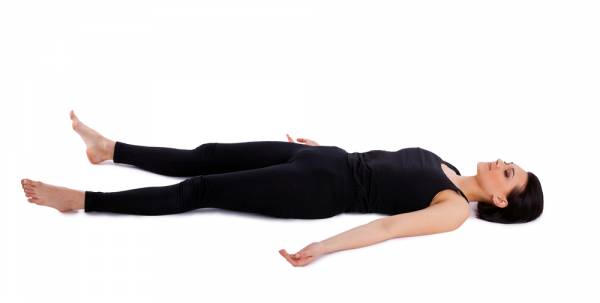
Last week, after I relaxed my eye muscles, the dancing double images of the ceiling vent directly above me fused into a nebulous whole. It wasn’t the 3D, popped-out vent I desire, but more of an elliptical shape that was a bit wider than a circle, shifting it’s shape a bit like it was under water.
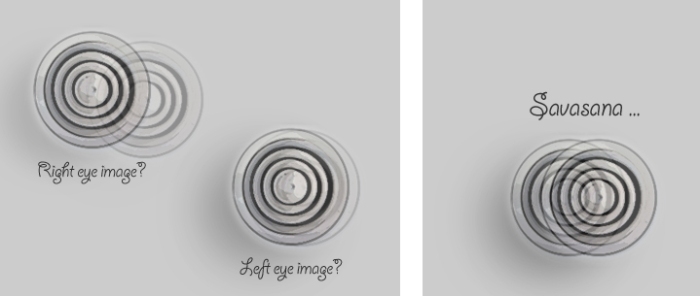
The best part was that the watery-looking but whole ceiling vent didn’t slide back to double, nor did my brain suppress one eye to see it more clearly— what usually happens!
In my last post I shared that “Letting go also requires giving myself permission to allow a new way of seeing to emerge, to be visually open-minded.”
Yoga is making this possible , and I am thankful.
Oh to be so care-free all the day long! I must learn to cast away care “without ceasing” as a heart attitude.
Casting all your care upon Him, for He cares for you. – 1 Peter 5:7
Relax. Let go. Give your brain permission.
I’ve been following this VT patient’s progress reports with interest. Today’s post “Stop trying so hard and just SEE” mentions a common hurdle to diverging our eyes, the ability to RELAX those rogue eye turn-in muscles! “Stop LOOKING” my VT would often say. LOOKING to isolate something normally fixates both eyes on an object, or in my case, unconsciously fixates one eye while turning in and suppressing the out-of-alignment image of the other. “Soften your gaze” was another frequent VT exhortation.
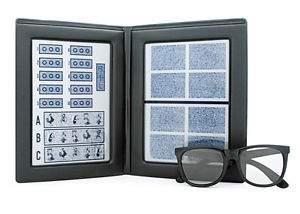 Last week, random dots did the trick of NOT LOOKING for this VT patient, and I think I understand why. The randomness of the thing viewed eliminates the worry about getting a “right” answer, and therefore is less stressful than “Is the elephant or the fly popping out for you?” which can trigger frantic LOOKING.
Last week, random dots did the trick of NOT LOOKING for this VT patient, and I think I understand why. The randomness of the thing viewed eliminates the worry about getting a “right” answer, and therefore is less stressful than “Is the elephant or the fly popping out for you?” which can trigger frantic LOOKING.
Randomness is the opposite of representation, therefore the brain lets go of the need to comprehend and interpret an object. As an artist who strives to accurately represent objects, a good dose of randomness may be exactly what my brain needs to stop trying so hard.
This is why, for me, letting go also requires giving myself permission to allow a new way of seeing to emerge, to be visually open-minded.
I’m rejoicing that random dot stereograms are working for this patient to overcome her eye turn-in along with the many awesome mind-opening exercises her Vision Therapist is tailoring to wake up her brain.
By letting go and giving herself permission to see a new way, her world is opening up into the third dimension I long to experience.
No Better Than a Placebo
New research is tracking brain changes in patients who undergo binocular vision therapy. Combine objective fMRI data and the many blog posts by adult therapy patients, and you have exponential evidence that vision therapy works for adult patients, and is getting better and better at targeting each patient’s unique visual needs to generate success.
All you need, therefore, is a therapist with an interest in helping the adult patient with the newest cutting edge stuff like Oculus Rift who happens to be passionate about binocular vision and works with adult patients within 100 miles.
My own home-based VT with a little help from an optometrist in my village pretty much ground to a halt in October. I even cancelled my monthly visit, acting out a deplorable level of avoidance behavior I am ashamed to admit. I did manage to make a 15 minute visit in November to confess I had done nothing since September. I did not commit to more monthly visits, as I’ve not been doing any exercises.
This week’s post at The VisionHelp Blog detailed the new neural research with a link to a TED talk by Tara Alvarez, Ph.D. In the midst of the good news was a succinct explanation for my own self-imposed hiatus:
… in the video she notes that in the landmark CITT study … home-alone therapy was no better than (a) placebo. A significant reason for this, she speculates is that the currently available home-alone therapy is gosh-awful boring and compliance is therefore lacking. Another potential reason is the patient may not be doing the therapy optimally because of lack of feedback from a therapist.
Boredom plus lack of solid feedback are indeed primary causes for throwing in the towel. In addition, the exercises exhaust me. I recently read of another patient’s progress at the Mindsight blog and he/she continually admits to the need for SLEEP. I battle feeling totally fried after just 2 minutes of Brock staring. Even looking at motion parallax while my husband drives places cooks my noodle on a good day. And, while this patient is making measurable progress, I lack any measurement but my own guesstimates, and wonder if they are even accurate.
Where do I go from here? Three years ago, the Vision Therapist working under my Developmental Optometrist offered to stay in touch via email, because she is a fellow adult strabismic and was undergoing Vision Therapy to gain binocular vision at the time. I’m curious to know if she has made progress. Curious enough to contact her.
Meanwhile, I have my “Map of Fellows” grabbed from the “Locate a Doctor” search at covd.org … the closest Fellow is the Developmental Optometrist I worked with before my BRAO in 2010-11 where the aforementioned strabismic VT works. In 2010 that Fellow was somewhat reluctant to take me on (due to the dearth of data confirming adult success) and suggested a more progressive Fellow in Cleveland. My sudden blindness in March 2011 put frosting on that reluctance cake.
Cleveland is far, but a less stressful drive than going to Pittsburgh through the hills on back roads and secondary highways. But my driving back home from Cleveland through Akron and Canton for over an hour, fighting heavy traffic AFTER the weekly brain-frying session? No. No. No. Not safe …
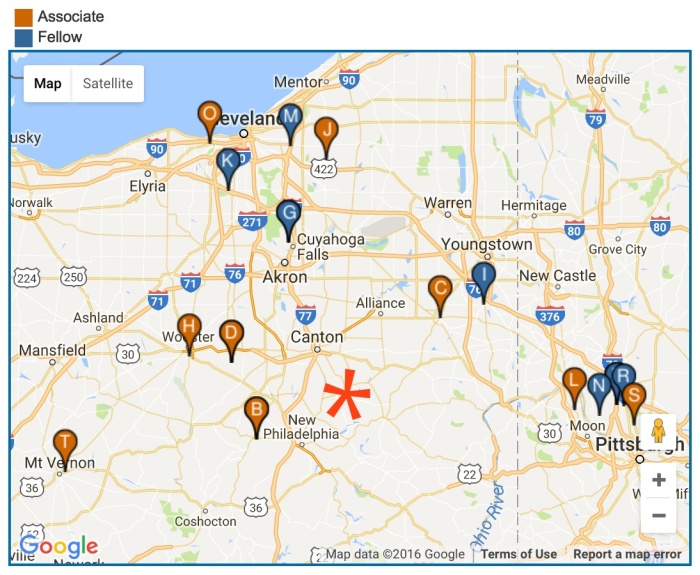
And so, my hiatus remains. But my interest is still on fire. That may never change.
My Frustrating Friday …
Driving in to my landscaping job, I went to my usual stress-free parking spot (a small gravel parking area not also inhabited by large trucks and heavy equipment) and found a coworker had parked his small car at an enormous angle, leaving me a tight spot. I didn’t know just how tight until I pulled in and couldn’t open my door … enough. I should have just backed out and gone to the other gravel area with the big trucks and the other guys milling about everywhere, but that was even more stressful: aka. the spectre of possible public humiliation to ramp up my nervousness. So I pulled forward, thinking, “If I clip his mirror, it will fold and not be harmed (like at the ATM machine.)” Wrongo! My stubborn mirror popped his mirror’s outer cover and another clear piece that covered a light.
After putting the pieces in his car, I found and told him about my “poor judgement” and offered buy him a new pieces if anything was truly broke. “That’s ok” he said.
Private humiliation turned semi-private. I couldn’t get out of there fast enough, before the event was shared with the other guys and … my boss.
At a client’s house, I was told I could park at the bottom of his hilly drive. So, in a company truck that has taken me a couple of years to figure out it’s true relative size to it’s surroundings, I pulled down and realized I was in deep trouble. There was no room to turn around, meaning I would have to back up a steep curved drive when I finished.
Fortunately the client came out. “You can back up on the lawn to turn around.” He said. Seeing my obvious jubilation, he made a comment about women not liking to back up as much as men. “It’s not that,” I say “It’s just that I can’t see 3D.” He was doubtful, but as we talked more about my stereo blindness, he admitted he does pencil push-ups to help his eyes team after cataract surgery!
Upon returning to the scene of my crime at base three hours and four jobs later, I observed that my co-worker had popped the cover back on his mirror and moved his car, as far away as possible, from mine. I noticed that the small clear light cover on the mirror extended beyond the black band encircling his mirror. My inability to see 3D failed to pick up on this important 3/4” fact.
After work, while fixing lunch, I manage to clip my ring finger, just below the nail, as I glided a plate from point A on the high counter to point B on the low counter, knocking over a glass bowl of egg salad. I got a nice blood blister on my finger in addition to my bruised ego.
Vision exercises at 5pm before dinner provided the usual impasse where I can’t see the Brock string center bead clearly at any distance over 12” … this has been going on for weeks.
I could use a breakthrough.
But instead of continuing to feel sorry for myself, I want to share about Atticus. Kids in schools everywhere need a far more important breakthrough, especially when their needless suffering is way more severe than my own ever has been. Give a listen to Atticus’ appeal for visual accommodations before the Board of Education.
The cherry of top of this video is the last comment by a School Board Member: “Atticus, I want to you know I have the same thing, and I really understand how you feel.” Even if she has a less severe variation of Binocular Vision Disorder (or Insufficiency), she gets it!
The Baltimore Sun has just reported Atticus’ appeal, and his Mom’s advocacy work to implement visual accomodation compliance to Maryland law for those struggling with Binocular Vision Insufficiency in Maryland schools.
Visual system deficiencies are far more common than folks realize. There’s always more to vision than seeing 20/20.
Slowly, very slowly, the world is beginning to see.
Never Play to the Gallery
Words of wisdom from a man who maximized his unusual eyes:
David Bowie’s unique appearance was the result of an accidental injury to his left eye during a tussle with a friend as a teen. The friend’s punch landed close enough to his eye to cause the pupil to become permanently enlarged, a rare condition called anisocoria.
Read more about David Bowie’s anisocoria here.
What I noticed more than the difference in pupil/iris appearance in this clip was that he also appeared to have exotropia. His angle of eye deviation is so severe, it’s hard to tell if he’s looking at the camera, or at an interviewer to his right … or both. It has a crazy way of driving his message home.
It would make sense that his brain would suppress the eye with the dysfunctional pupil. I could not find an article to verify his strabismus, but strabismus in the form of exotropia, where the suppressed eye is turned out, is my educated guess. He may have even patched his right eye in the 70’s in an effort to correct amblyopia that developed in the dysfunctional left eye, and used the patch to good effect!
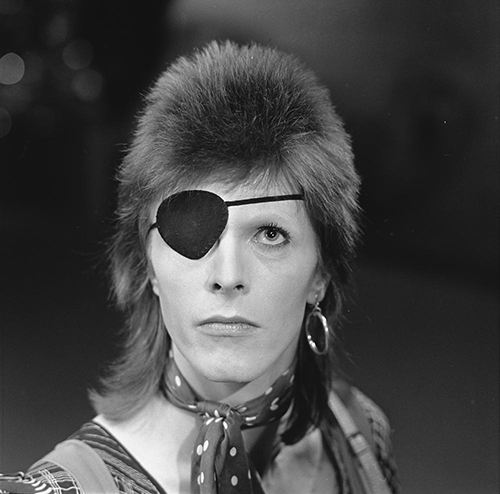
David Bowie, 1974 | Credit:AVRO
As a person with strabismus, I found his “Don’t play to the gallery” philosophy doubly inspiring. I can easily make the connection between his way of seeing everything differently and his commitment to remain true to his inner vision, no matter what others thought during his life.
It’s clear he did not let his unusual eyes get in the way of relating to people on stage or in interviews. If anything, his eye conditions informed his outlook on life and his music, as well as his other-worldly stage presence.
Bravo! Olé!
Eyes Contact Redux (or what happened in the optometrist’s office, part 1)
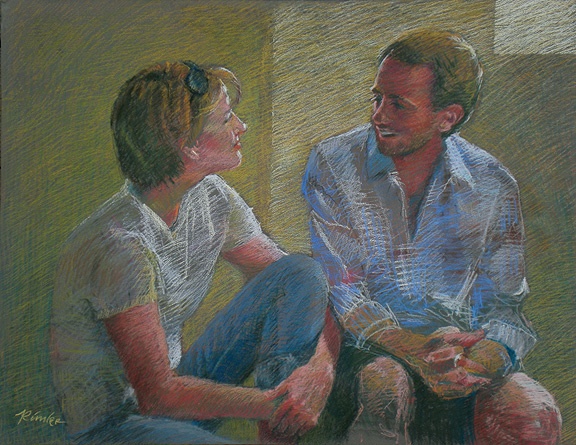
“The Colors of Relating” 19 x 24″ pastel on Canson paper by Lynda Rimke, 2009 Akron Society of Artists Open Model Night for Akron ArtWalk
During my vision therapy hiatus, I would from time to time succeed at looking at both my eyes in the mirror in the way most people make eye contact, “the act of looking directly into one another’s eyes.” 1
My felt need for mirror-practice is because “Strabismus … interferes with normal eye contact: a person whose eyes are not aligned usually makes full eye contact with one eye only, while the orientation of the other eye deviates slightly or more.” 2 I wrote more about this in 2010 where I had recently discovered the difference:
“Most people make two-eyed contact, with right eyes gazing into left and left into right. Al enlighted me of this fact only last week. It’s really eyes contact.” 3
While mirror practice is really right to right eye and left to left, softening my gaze to see both eyes at the same time achieves the same purpose. Since starting back on the Brock String in late June, I have been practicing in the mirror more.
When I explained this to my optometrist on Tuesday, he wanted to see if I could pull it off. For a second or so I couldn’t get it, then I tilted my head just slightly to the right. Then it happened: my first full connection with another human being— Real. Full. Eye Contact.
“You tilted your head,” he noted, and then warmly related how sometimes his vision doubles and head tilting is a way to get binocular function back. While I am not happy that this is happening to him, I am comforted in that whatever research he will be doing for me may also be of benefit to him.
I also used the Brock String with him holding the other end. My nervousness and the angle of the string, and difficult overhead office lighting made for less than ideal conditions. I think I got the “magic X” through the yellow center bead only for a millisecond or two at 15” and was not able to converge and diverge between the closer green bead and yellow bead.
But I digress. The actual genuine eye contact was THE huge milestone with psychological and social significance. I fake genuine eye contact pretty well, as my misalignment is now so slight as to be practically imperceptible to others. But I am always missing the connection by half. To have made that full connection, even for clinical purposes, is huge.
I mentioned this at dinner, after taking in a 3D movie with my folks and husband on Saturday. Dad, who claims to have always had a “lazy eye” took immediate interest, and we attempted genuine eye contact. I was surprised when he told me he was alternating, and I (and my husband next to me) could see his eyes doing it! We’ve suspected that my condition runs through his family, but this was an “Aha!” moment to see his alternating esophoria (or tropia) in action. We laughed at our struggle and then lovingly made left “good” eye to left “good” eye contact.
My husband has become the next victim, as I will not let go of my goal to improve my newfound full-eye-contact skills, and he happens to be the most handy human being around. We normally do a lot of talking with occasional face contact. He too, grew up with an impairment to real eye contact: congenital cataracts and coke-bottle glasses. I’m sure this is what made him easy to be around at first, as this made him undemanding in the eye contact arena. I did not mind tunneling down through his glasses with my one good eye. While the pop-bottle lenses are long gone, gaining that full eye connection has been a challenge, because face contact has been nothing less than eye contact in his mind his whole life and all that I felt I could easily accomplish. But he is patiently putting up with me, and why not? Every enduring marriage needs a little magic!
Brock Exercise Notes
June 27 – afternoon. my first time to Brock in a long long time. I was amazed that I could start out at 12 inches. I was also amazed that when looking softly over the yellow center bead I could get the double image of the rear red bead.
June 28 – afternoon. After a tiring day at work. Again I was able to successfully see the yellow bead at 12″with an “X” through it. But not much took place after that.
July 4 – late morning. More rested. I was able right away to nail yellow Bead it 12 inches. Then briefly, I could back it off to about 18 inches. But this only lasted for a millisecond. Then the whole thing deteriorated.
My other observation is that the right string image is always stronger in front of the bead I am converging on and the left string image is completely strong behind it. This confirms what I felt initially after the BRAO that my brain is vertically aligning upper and lower images from both eyes.
 July 9 – walked by my Brock string for the umpteenth time and told myself “Look— it will only take three minutes!” This time I decided not place the yellow bead at a specific place but just grab the first 12” mark near the front green bead and look. I was surprised that I could converge at 21”!
July 9 – walked by my Brock string for the umpteenth time and told myself “Look— it will only take three minutes!” This time I decided not place the yellow bead at a specific place but just grab the first 12” mark near the front green bead and look. I was surprised that I could converge at 21”!
July 10 – late morning, right after massage. Right off the bat I got 25”. Then things got a little wobbly. I got interrupted, but I was able to regroup and see the bead at 20”. I would call that an improvement!
Later that day or the day after, I see my fingers for the first time in 3-D. They were interlaced on my lap, with tips popping out toward me, and looking physically SOLID. It was so awesome I unlaced my right hand and just stoked those solid looking fingertips and then re-laced them once or twice. “So this is what REAL fingers look like.”
It was an almost spiritual experience, making this new connection with my own hands, and so I gave thanks for this new vision I didn’t even ask for. Grace …
July 14 – evening, after a long day on the road. Only managed 15″ convergence and that with only half the X: the right eye image of the string in front and left eye image of string in back of the center bead.
I decided after this poor “X” showing to pick blueberries for visual and emotional therapy. “Fast Cars” from U2’s How to Dismantle an Atomic Bomb played in my head. It fit my anxious mood in a happy U2 sort of way. The tomato plants were begging to be tied in the garden behind me, and the piles of laundry and dirty dishes were waiting inside. It all made my head pop.
But, during that forever time picking, I thought “the whole diplopia experience isn’t needed in real life, so maybe a half an X is ok and a whole X is not the ultimate goal with me.” I know my eyes are converging with just that half an X …
July 16– 2:30 in the afternoon seems to be the best time. I once again was able to see the bead at 19” then things got wobbly. I also could not get myself to see the red bead. But after that, a quick second attempt to see the yellow be succeeded at 24 inches. Doing this more frequently definitely has its advantages.
July 19– 8am just before headed out to my landscaping job, I decide a 10-second “goose” before a visually demanding day would be a good thing. I converged and diverged easily between the near green bead at 8″ and the yellow at 15″ — this is a first.
Seven brief sessions in three weeks, not 21 or more. 3x day is my goal …
Even with only those seven brief sessions, a couple of amazing things happened at my optometry appointment this afternoon. But that’s another blog post!
“Why Don’t You Ask Me?”
I can’t begin to describe my emotions. This desire to keep working at vision therapy in some fashion has never left me over the last five years, since the March 2011 Branch Retinal Artery Occlusion brought my program with my Developmental Optometrist to an irreversible halt. “You are not binocular” I was informed one year out, with what felt like a firm, conversation-ending “period.” Even so, I sat there and meekly persisted to ask about doing vision therapy exercises, although the visual field in my half-blind right eye had not changed. “You can play around with it …” she offered. Whether this was her intent or not, I received this withering assessment as hopeless, and allowed hopelessness to bury my desire.
But desire simply squirmed in rebellion from time to time at the bottom of its grave. This deep inner writhing has occurred, without fail, every spring when my work outdoors brings fresh binocular-like quales, those take-your-breath-away sightings of something more.
Am a really so hopelessly “not binocular”? Isn’t binocularity a continuum? Are my quales perhaps peripheral fusion or ARC? Can’t I work to become a wee bit binocular?
Who has stopped me from working at it? No one.
Not even God, Himself.
Shortly after the “You are not binocular.” office visit, I suffered a painful irony: In June 2012, my artwork had earned a “People’s Choice” prize that cut me to the quick.
I had to make a special trip out to the gallery to pick up my prize, which turned out not be the badly needed cash I was anticipating (we were tied up with two homes at the time), but a “how to paint” DVD of some smiling unknown artist with his simple barn painting.
About half way home, when I stopped to pick up groceries, I swallowed my “I painted a better barn at this competition!” vanity and opened myself up to the idea that maybe, as an artist, I could learn something from this particular barn-painting demonstration. So I read the back. In all caps, this unknown artist stated:
I LOVE TO PAINT. I LOVE TO CAPTURE THE ESSENCE OF A THREE DIMENSIONAL SCENE IN TWO DIMENSIONS. IT’S MY PASSION.
I don’t cry often, but this was an astounding dart to my heart from the blue. I fought back the tears, threw the DVD on the seat and went grocery shopping.
Enroute home, about 100’ from my driveway, I sputter at God in a howl “What is this, some kind of cosmic JOKE? You KNOW I can’t see three dimensions!!!” This Creator gave me a brain that prefers alternating esotropia. This Creator allowed that tiny blood clot to enter the branch artery of my dominant right eye and stay there. What was He thinking?
As I brought the car to a stop, a question invaded the wound in my heart: “Why don’t you ask Me?”
And so I have continued to ask, haltingly, not for an answer to what this Creator is doing, but to see more with the two eyes He has given me, more than I ever have seen before.

“Kishman’s Barn” oil on canvas by Lynda Rimke. Painted “en plein air” June 2012
Schools Need Binocular Vision Screening
I read about an appeal to write my congressman from the “Let Them See Clearly Campaign” to add binocular vision screening to a bill, as posted in a DIY Vision Therapy Group I belong to on Facebook.
I emailed a rather lengthy letter to my House Representative about three weeks ago, using the campaign’s information, and adding my own research and brief personal story. I haven’t heard back, but hope to. It seems to me that adding binocular vision screening to this bill would be a good fit. Here’s why (Although I just learned after posting that the writers want to create a separate bill*):
To the Honorable ….
re. H.R 3535 the “Alice Cogswell and Anne Sullivan Macy Act” in Committee
Dear …..
H.R 3535 should add screening for binocular vision (BV) impairment to the vision screening protocol to identify students with visual disabilities.* BV is tested via an assessment of eye focusing, eye teaming, and eye movement abilities (accommodation, binocular vision, ocular motility.)**
Under the “Categories of Disability Under IDEA” (Individuals with Disabilities Education Act), “Visual Impairment Including Blindness means an impairment in vision that, even with correction, adversely affects a child’s educational performance.”(1)
The Visual Impairment definition further states: “Most of us are familiar with visual impairments such as near-sightedness and far-sightedness. Less familiar visual impairments include: strabismus, where the eyes look in different directions and do not focus simultaneously on a single point…” (2)
Strabismus (Esotropia and Exotropia) is just one of many Binocular Vision impairments. More common ailments are:
Convergence Insufficiency, where the eyes fail to team together to see things up close. “Convergence is the coordinated movement and focus of our two eyes inward on close objects, including phones, tablets, computers, and books.”
Amblyopia or “lazy eye” where the brain suppresses the image from one eye because the image is different than that of the other eye.
Diplopia or double vision
Esophoria or exophoria, where the suppression of one eye is intermittent.
Strabismus, as either Esotropia (“crossed eyes”) or Exotropia (“wall eyes”), occurs when the suppression of one eye is well established.(3)
Undiagnosed Binocular Vision Impairments are increasingly triggered in children by our convergent-based technology, which requires turned-in eye-teaming on phones, tablets and computers, with little outdoor play to aid binocular vision development. (4)
Unfortunately, at the same time, children in school are being misdiagnosed in IEP’s when binocular vision problems inhibit learning. These children can and should receive an early diagnosis and, hence, the opportunity to pursue certified optometric vision therapy and/or recommendations from an Opthalmalogist to normalize visual processing and improve learning ability and quality of life.
Furthermore, IEPs must include accommodations necessary to aid the child undergoing optometric vision therapy as advised by their Doctor of Developmental Optometry, in order to not undo progress made under vision therapy. This may include not forcing the child to read, for example, until her unstable convergence issues are resolved.
-13 to 20% of the population have impaired binocular vision that is 75% curable according to a double blind study by NEI (5)
-Studies by ADHD and vision experts show 20 -25% are misdiagnosed and have binocular vision impairments (6)
-Autism.com says studies show that 21 to 50% of autistic children also have binocular vision impairments. (7)
“Binocular vision impairments are more common than you may think. Just one type of binocular impairment, amblyopia (“lazy eye”), affects approximately 3% of the population. At least 12% of the population has some type of problem with binocular vision.” (8)
As an adult with alternating esotropia, a form of strabismus (crossed-eyes), I can’t begin to tell you how much better my quality of life would have been if my condition had been diagnosed and treated while I was a child in the 1960s. My parents gladly spent money to straighten my teeth, not realizing that all their harping about my feet turning out and my poor posture was due to my eyes not teaming to create a visual center-line for my posture and gait. This of course made gym class excruciating, as I was always the last to be picked for any team (imagine trying to catch a fly ball without any sense of depth) and also made socialization difficult as other children did not know if I was looking at them or something else.
Instead of learning how to use both eyes together, in early childhood my brain spent extra energy suppressing the vision of one eye or the other to avoid double vision. While my early well-established suppression allowed me to read without difficulty in 1st grade, it has lasted for a lifetime.
The extra energy expended by the brain to suppress vision and live and move by monocular depth cues, instead of fusing vision from both eyes to see palpable space and distance, limits one’s ability to: multitask on any level (how many jobs require this?); drive well during demanding depth needs (e.g. driving multiple sized vehicles on the job); work in food service, landscaping, auto-mechanics, carpentry, etc.; participate in sports or recreation (eg. yoga, dance, catching or hitting a ball); or watch 3D movies (the latter is impossible.)
Please, please, make screening for binocular vision issues a goal, so that 12% of the population can benefit from early vision therapy intervention to avoid the everyday pitfalls this hidden, subtile disability creates, which must be endured for one’s entire life.
Respectfully
Lynda Rimke
https://leavingflatland.wordpress.com
*For reference:
Title II—IMPROVING THE EFFECTIVENESS OF SPECIAL EDUCATION AND RELATED SERVICES FOR STUDENTS WITH VISUAL DISABILITIES
Subtitle A—General Provisions
Sec. 201. Identifying students with visual disabilities.
https://www.govtrack.us/congress/bills/114/hr3535/text/ih
** https://covd.site-ym.com/?page=Exam
(1) http://www.parentcenterhub.org/repository/categories/
(2) http://www.parentcenterhub.org/repository/visualimpairment/
(3) http://www.covd.org/?page=VisionConditions
(4) https://nei.nih.gov/sites/default/files/nei-pdfs/VisionResearch2012.pdf p50 “spending time in bright outdoor light appears to be important for normal eye development…In 1972, approximately 25 percent of the U.S. population, 12–54 years of age, were nearsighted, compared to 42 percent 30 years later”
The Binocular Vision Dysfunction Pandemic http://c.ymcdn.com/sites/www.covd.org/resource/resmgr/ovd41-1/editorial_binocularpandemic.pdf
(5) https://nei.nih.gov/news/pressreleases/101308
(6) http://www.add-adhd.org/vision_therapy_FAQ.html
(7) https://www.autism.com/treating_vision
(8) http://www.children-special-needs.org/questions.html
For further reading:
American Academy of Optometry Binocular Vision, Perception, and Pediatric Optometry Position Paper on Optometric Care of the Struggling Student For parents, educators, and other professionals August 2013
http://c.ymcdn.com/sites/www.covd.org/resource/resmgr/position_papers/revised_oct_18_bvppo_positio.pdf
http://www.covd.org/?page=VisionConditions
http://www.covd.org/?page=Vision_Therapy
* Let Them See Clearly Campaign LTSCC just commented on my Facebook share today: After meeting the HR 3535 writers from the American Federation for the Blind, they thought that though HR 3535 should pass that BVD needs its own bill. They said it was a statement piece that the extras may bog down my efforts and never pass. I do think a BVD on its own would be best and will talk to my legislation writer and my rep contacts about options. Thanks for the blog. HR 3535 should pass and will help with BVD along with a comprehensive bill. Working on that. :) Thx for your help
I replied: Let’s hope for the best. I’m going to add your comment to my post. Thanks.
And then, later: I’ve been thinking about this. I’m not happy they think comprehensive screening isn’t part of the bill. I mean, come on, how hard is it to add a simple cover uncover test and use a pen light? https://www.youtube.com/watch?v=ZErvGS1EqyM
And just now: Ok, I remember— those two tests only discover well-established strabismus and not other binocular vision issues such as convergence insufficiency, which is far more common. Maybe a full bill just for Binocular Vision Disorders is the better idea … if it ever gets written!
Playing At Last
It’s been five years since my BRAO and two years since choosing to keep the same base-right prism for my second set of glasses. At that office visit with my Developmental Optometrist, I could not walk a straight line with the prism, with more prism or without prism. I simply went with the same strength based on my own observations here.
From time to time, I have put on my red-green glasses, and the amount of red I have seen clearly shows me that I still use my half blind right eye with my left by default as I described here.
But I have not done anything in the way of Vision Therapy. That is about to change.
This spring I began to fervently wish, once again, for NO prism other than something to help my half-blind right eye: the kind of prism that was used in an office visit just after my BRAO in 2011 to help me see the Brock string a little better.
My fervor deepened into what felt like rebellion:
- I wanted to “take off the training wheels” by going back to NO prism.
- I wanted to take ownership for what was wrong in my head.
- I wanted to work on my posture to align with true center with the balance board, yoga exercises and massage therapy
- I wanted to revisit the Brock String, hang on to that “X” that marks my true center with BOTH eyes, and push it further.
This June, I got an eye exam from another optometrist who had no objections to going without base-right prism. He prescribed new progressive glasses, with a bit more magnification for reading and NO prism. Furthermore, he was willing to work with me to possibly prescribe a stick-on prism so that I can experiment with the Brock string. I have an appointment to assess what amount of prism, if any, would be helpful on July 19 and to discuss my vision goals. I get to bring in my Brock String! I am as excited as a kid in a candy shop at the thought of having possible access to a few new Bernell toys to play with.
Today, after five years, I got out my Brock String, now slightly yellowed, and tied one end to a doorknob and checked my fusional area in the hallway. There is no denying I still have a fusional area! Just as before, I could line up the “X” the string images from each eye make around the yellow bead (this time at 12”)
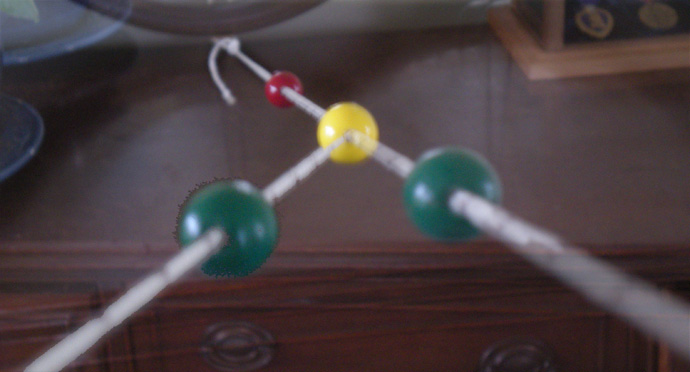
How my Brock String appeared in April 2011
But, instead of seeing the string disappear behind the bead due to the blind area in my right retina, I could see some string, flickering in an out! A full “X” image! Furthermore, if I looked at the “X” around the yellow bead AND the red bead that was 12” behind it (the big picture?) I could easily see and hold the image of those two red beads in back!

How my Brock String looked today
Resurrection, unburying my desire, has been a long process of facing my very deep personal hang ups and fears, and moving back to that place of risk-taking.
But I am doing it!